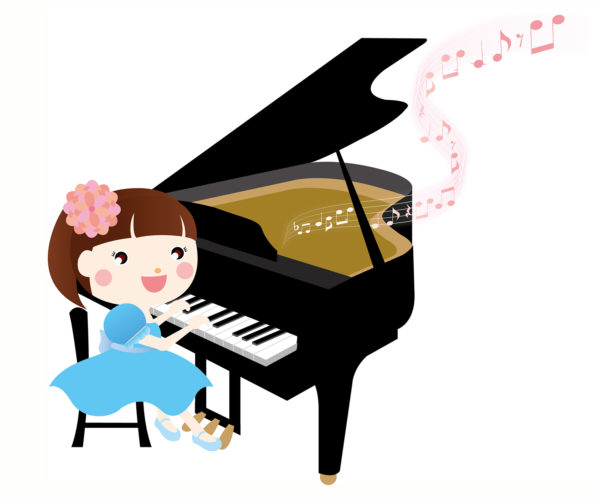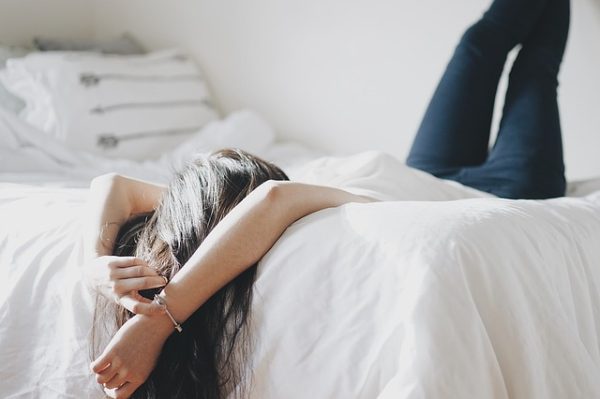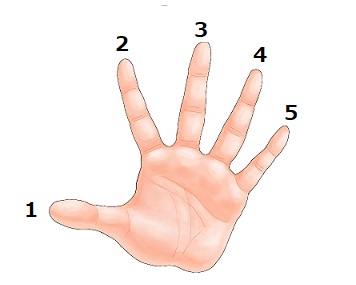アルペジオ(アルペッジョ)とは、和音の音を低い音から(もしくは高い音から)単音で順番に連続して弾いていく事を言います。
アルペジオは分散和音の中の一つであり、弾き方はハープの演奏のように演奏します。
アルペジオの弾き方

アルペジオは先述の通り、単音で順番に和音の音を弾いていきます。
まずはこちらを御覧ください。

こちらは下半分に「もともとの和音」を、真ん中に「コード名」を、上半分に「アルペジオ」を記載しています。
このような場合どのように弾けばよいのでしょうか。
無理やり音符を書き換えたものがこちらになります。

こちらも同じく下半分に「もともとの和音」を、真ん中に「コード名」を、上半分に「アルペジオ」を記載しています。
丸かっこは「スラー」ではなく「タイ」ですのでご注意ください。
今回は32分音符で書き換えています。
このように、和音の音を単音で順番に弾いていき、もともとの和音の音の長さに合わせたものがアルペジオの演奏方法です。
ちなみに、今回は和音とアルペジオの音が始まるスタートのタイミングを合わせて楽譜に記載しました。
逆に和音が始まる前に単音を弾いていき、単音を全て引き終わるタイミングと、和音のスタートのタイミングを合わせても問題ありません。
アルペジオの速さについて

先程アルペジオを32分音符で書き換えましたが、アルペジオは正確にはどのぐらいの速さにすると良いのでしょうか。
実はアルペジオの速さというのは正確には決まっていません。
あくまでも弾き手の間隔なのです。
そのため極端に言えば128分音符の速さで単音を弾いていくこともアルペジオになりますし、8分音符の速さで単音を弾いていくこともアルペジオになるのです。
しかし、いくら和音が全音符だとしても、4分音符の速さで単音を弾いてアルペジオにしてもそれは全くアルペジオの意味をなしていません。
アルペジオはあくまでも「分散和音」であり、「単音」ではありません。
理想は、それぞれの単音が聞き分けることができる速さかつなめらかに演奏できる最も速いスピードで演奏することです。
しかし、慣れないうちから速いスピードで演奏しても「なめらかさ」がなくなり、聞き手にとって不協和音を聴くように違和感を与えてしまいます。
まずはゆっくりなめらかに演奏するようにしていきましょう。
ピアノのアルペジオの練習方法

ピアノの準備ができたら、あらゆるタイプのアルペジオを演奏する練習をしてみましょう。
アルペジオと一言にいっても和音そのものには数え切れないほどの種類があります。
それらすべてのアルペジオをするわけではありません。
アルペジオを練習する前に

アルペジオを練習する前にまずは力を抜かなくてはいけません。
アルペジオを弾く場合、基本的には根音である音は右手であれば親指、左手であれば小指になります。
サッカーでキックをするときに軸足が大事となるように、ピアノのアルペジオにおいても最初の根音が最も大事な部分となります。
根音から指が絶え間なく波のように動く必要があります。
この波の動きをなめらかにするために、肩と手首をリラックスしましょう。
背中をまっすぐに保ち、肩と床を平行に(なで肩ではない限り)しましょう。
もしアルペジオを弾く際に体を動かす必要がある場合、その体制のまま腰を左右にひねることができるようにしてください。
姿勢についてはこちらを御覧ください。
また指の筋肉を鍛えておく必要があります。
基本的には親指・中指・小指を使うことが多いですが、当然人差し指や薬指も使います。
右手は親指から、左手は小指から5本の指で鍵盤を順番に押していく際の指の動きを制御する筋肉を鍛えましょう。
スポーツの筋トレのようなことではありません。
日頃からリズムを刻むときに、親指→小指まで順番に「タタタン」とリズムを刻んでみましょう。
この指の動き方は最初からマスターできるわけではありません。
ピアノから離れた場所、運転中や電車の中で聞こえる音楽、鼻歌を歌っているときなどに、手をたたくのではなく、指で順番にリズムを刻んでみましょう。
指を決める

実際の演奏では手や指が絶えず動き続けます。
アルペジオに限った話ではありませんが、最初のうちは演奏のたびに打鍵する指が変わってしまうことがあります。
本人にとっては指が多少変わっても同じ音を演奏しているつもりでも、聞き手にとってはその違いははっきりと分かる場合が多いです。
演奏の中ではアルペジオ単体で使用するであろう指ではない、別の指を使ったほうが前後の音からつなぎやすい場合があります。
前後の音、指の形を考えながら楽譜の中にあるアルペジオは予めどの指で演奏するのか決めておきましょう。
テンポを意識する

アルペジオは「なめらかに」演奏することが前提です。
この「なめらかに」演奏する最大のポイントは、そのテンポを揃えることです。
実際にアルペジオを弾いて練習してみましょう。
このとき、アルペジオの細かい単音のリズムをメトロノームを使って正確なリズムで演奏するようにしましょう。
アルペジオの場合、演奏した音(指)はそのまま和音が終わるまで鳴り止むことはありません。
通常は「なめらかに」弾くために指を離すタイミングも重要なのですが、今回は考える必要はあありません。
あくまでも、鍵盤を押す(打鍵する)テンポを正確に揃えましょう。
はじめから高速で演奏する必要はありません。
最初はゆっくりと、あくまでも「テンポを揃えること」を意識して単音を弾いていきましょう。
あとはひたすら練習を重ねるだけです。
ただし、一度にアルペジオだけを練習しすぎないようにしてください。
大事なことは練習を継続していくことです。
自分を追い込みすぎず、甘やかしすぎず、適度なスピードで練習していきましょう。
アルペジオ以外にもある分散和音

アルペジオは分散和音というものの一つなのですが、よく「分散和音=アルペジオ」と勘違いしている人もいます。
これは本来の意味から言えば間違いです。アルペジオの他にも分散和音はいくつかあります。
※ただし、もともとは間違いでもそれが一般化すると、それは新しい常識になります。いずれ「分散和音=アルペジオ」と広辞苑にも記載がされるかもしれません。ただ、海外では通用しないと思います。
他にはどんな分散和音があるのか、いくつか例を上げてみます。
・アルペジオ

・アルベルティ・バス

和音の「低い音」→「高い音」→「中間の音」→「高い音」と演奏していくパターンです。
主に古典派と呼ばれる音楽でよく使われており、モーツァルトのピアノ・ソナタなどにも使われています。
バイエルのような教本をお使いの方にとっては馴染みのある分散和音だと思います。
・”ポップパターン”

「ポップパターン」とニックネームが付けられているこの分散和音は、和音の根音とそれ以外の音を順番に演奏していきます。
特に現代のJ-POPなどの音楽で見られることが多く、代表的な例として、レミオロメンの「粉雪」のイントロや、ジョンレノンの「イマジン」のイントロなどが挙げられます。
最後に
アルペジオは、スポーツチームが練習の前にウォームアップするように、音楽を練習する前に手を暖める素晴らしい方法です。
ときには和音の高い音から順番に単音を弾いてアルペジオを完成させてみましょう。
普段使わないような指の筋肉を鍛えるだけでなく、脳にいい刺激を与えます。
速さも弾く順番も決まっていないアルペジオは、楽譜の型にハマって演奏する中でもクリエイティブに演奏できるものです。
あなたの創造力で、自由にアルペジオを弾いて曲により深みをもたせましょう。
コメントを残す